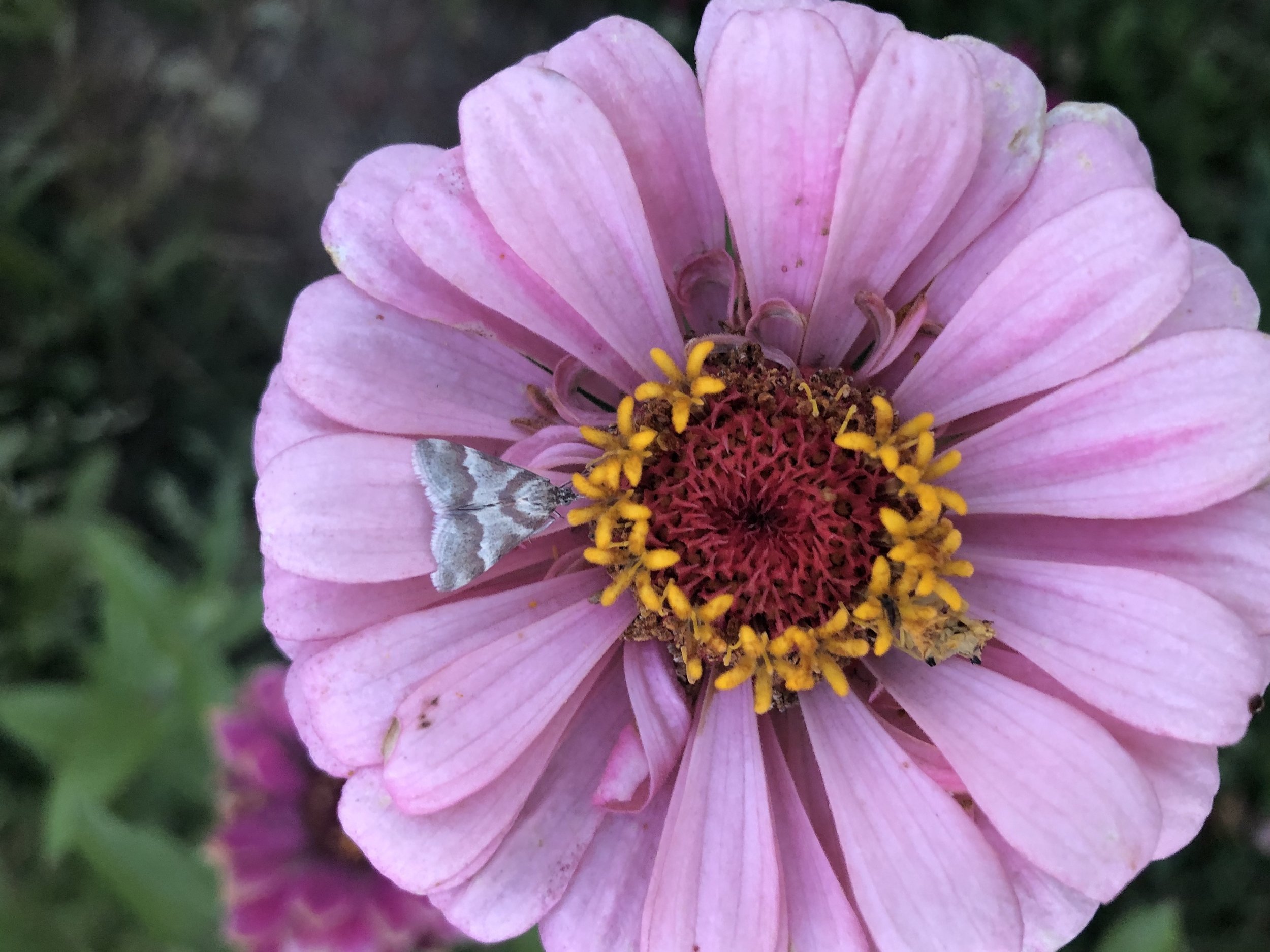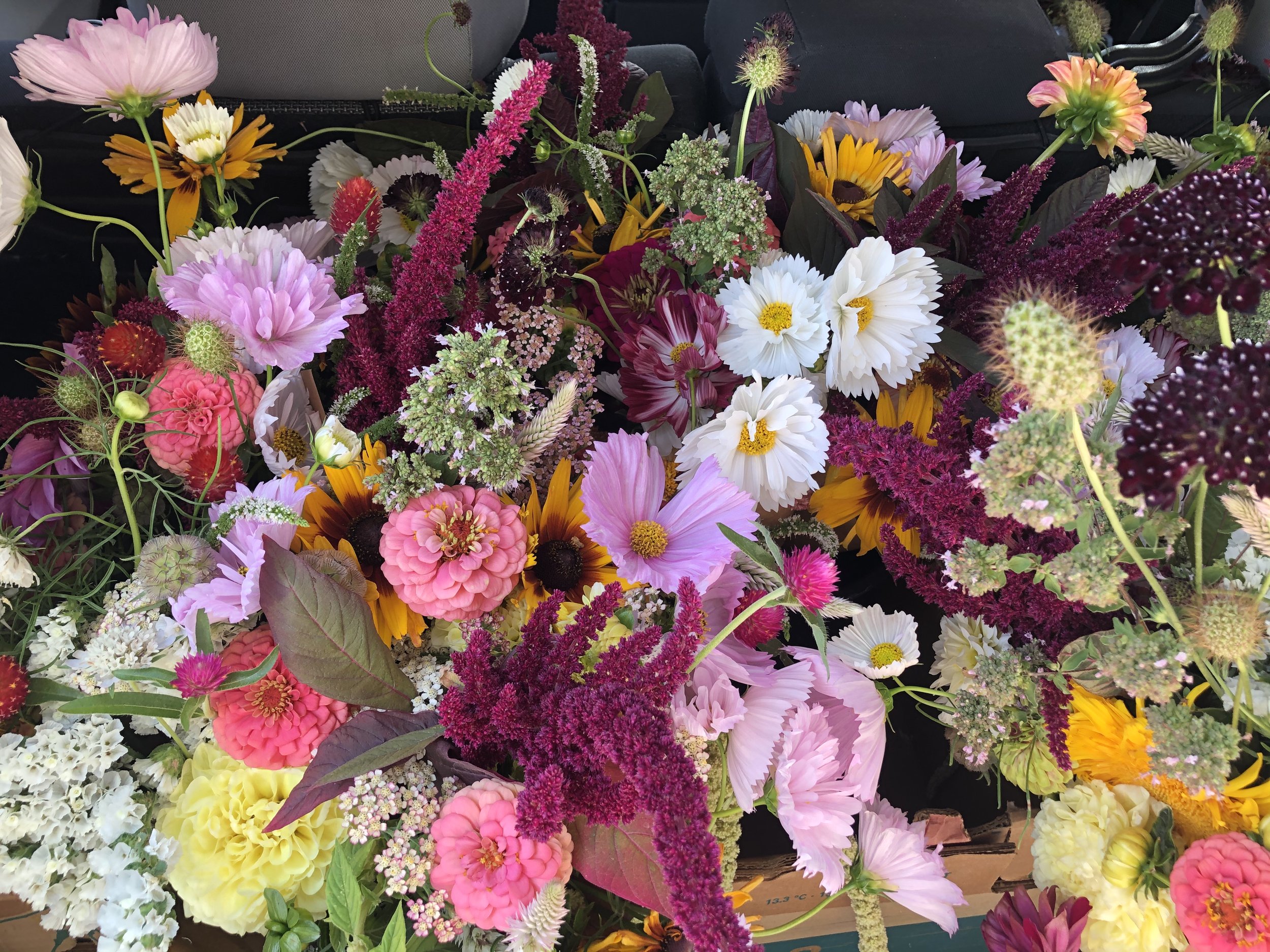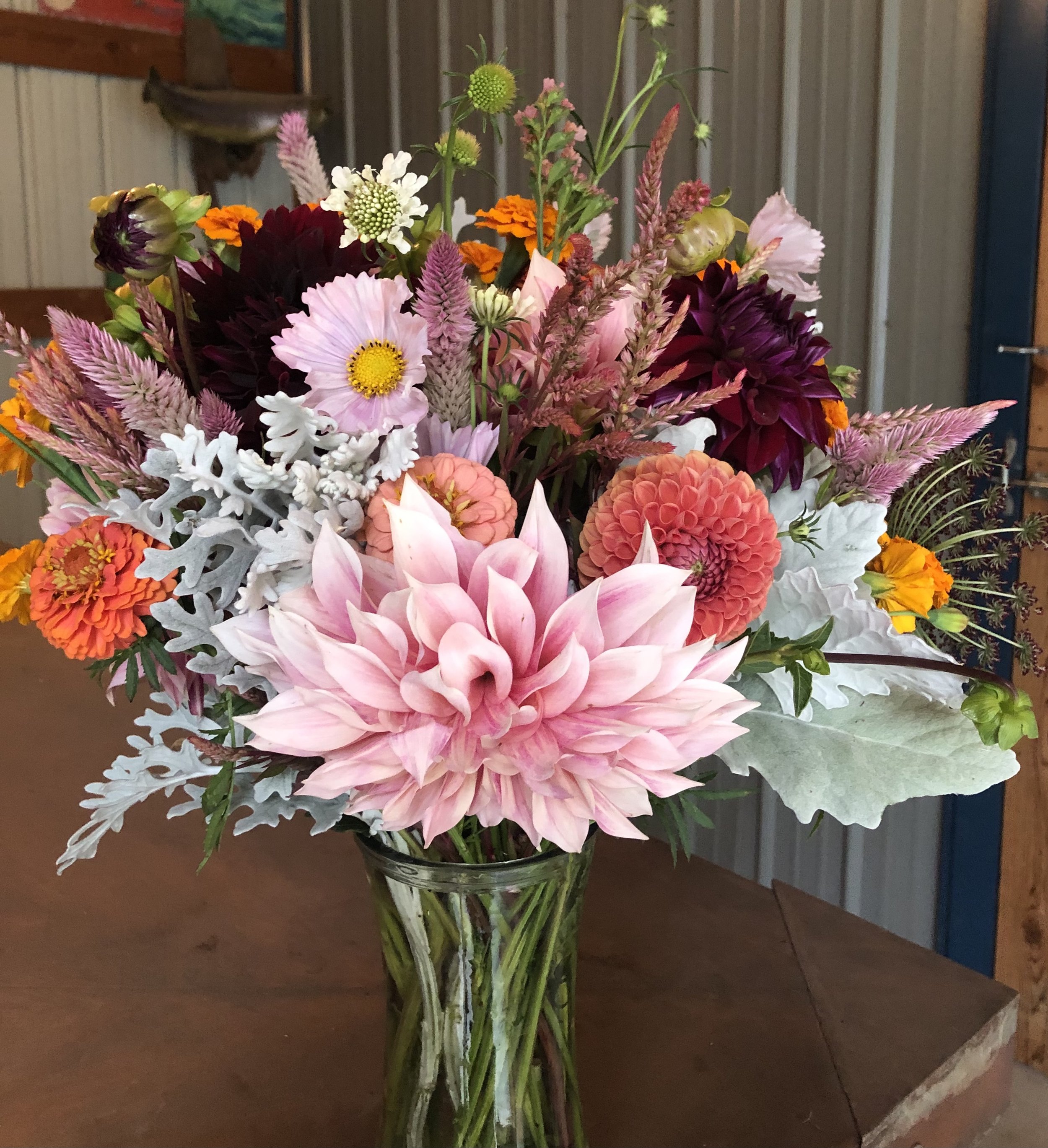Growing Flowers Can Combat Climate Change: Here's How
What if someone told you that helping combat climate change can be as simple as creating photosynthesis, a.k.a growing plants. The current global dilemma of our rapidly changing climate has many solutions, and one of the major solutions is saving our soil through regenerative farming practices. (And yes, you can use regenerative farming techniques whether you grow flowers on a farm or on a small balcony.)
Gardeners, farmers, and floral professionals can be a significant part of the solution by choosing some fairly simple practices that can contribute to cleaning up our air, water, and soils, while growing beautiful flowers or sourcing flowers from farms that use these practices. To achieve this, we must understand our soil, carbon, and where we fit into this seemingly larger-than-life puzzle.
Solutions to climate change can sometimes feel overly simple yet unattainable at the same time.
As flower lovers, we all want to make the world a more beautiful place, and beautifying your corner of the world with a strong focus on soil health is a great place to start.
We can be a part of the solution by utilizing regenerative agriculture methods (like climate- or carbon-farming). This is a very general introduction to some of the ideas behind this movement, as the topic is extensive and has many roads to implementation, depending on your scale.
What Is Regenerative Agriculture?
Regenerative agriculture is a method of land management that is not new. It’s an age-old way of growing in tune with the land by giving back what you take out.
Some of the methods were historically practiced by Native Americans and included elements of permaculture, organic growing, and biodynamic agriculture.
It is not so much a strict set of guidelines, but a general philosophy that focuses on the following:
Soil health
Biodiversity
Prioritizing the health and equality of naturally occurring systems (such as water, nutrients, and animal and human health) while eliminating methods that are harmful to the earth
While incorporating some aspects of organic farming, regenerative agriculture takes things a step further by focusing on long-term sustainability, limiting inputs, and greater consideration of all living elements integral to a healthy ecosystem.
Growing using regenerative methods is a major contributor to carbon capture from the atmosphere (offsetting harmful carbon emissions). It provides numerous other benefits, including increasing the livelihood of pollinators on which our food supply depends.
Whether you’re growing in containers on a balcony or a 60,000-acre farm, it’s possible to utilize some of these methods and make conscious choices to support local agriculture that practices them.
Buying local flowers is a fantastic way to help small floral businesses and get a superior product. Seeking out farmers and ranchers in your local food web who practice these methods can significantly contribute to the solution.
Understanding the Importance of Soil
To understand soil, we must know that it is not simply dirt—it’s a vital natural resource teeming with organic and decayed plant material, micro-organisms, air, water, and minerals. It should be porous and able to retain air and water freely.
Fertile soil is a living and life-giving organism that can contain up to 1 billion microbes per teaspoon and can offset a massive amount of carbon emissions. According to Soils.org, no-till practices can sequester an average of 0.3 metric tons of carbon per acre per year!
Healthy soils also provide an ideal environment for insect habitat where they contribute to soil aeration, soil fertility, and help regulate other insect populations.
Why is soil health so important for our future?
The majority of our workable soils and farmland worldwide are reaching a state of desertification, and this must be remedied.
Desertification is a term that refers to degraded soil condition, mainly from deforestation and many decades of destructive farming practices (particularly annual tillage and repeated high doses of pesticide application). Unfortunately, this soil state contributes to drought, altered weather patterns, and an extreme lack of soil fertility, which will eventually fail to produce crops in the distant future.
For those flower farmers and gardeners out there—you know how vital your soil is—in fact, it is all about the soil.
In my case, we have transitioned to no-till/low-till practices on our property and aim for minimal disturbance to the land to increase soil health.
To increase soil fertility and hold more soil organic carbon, consider some of the methods below depending on crop needs:
Eliminate any -cides, or pesticides and killer chemicals. Use companion planting, biodiversity, healthy soil, and natural pest management to help keep your ecosystem in balance.
Soil test in the fall, then add amendments as necessary (You may skip this step if using pre-made soil mixes in raised beds or containers).
Grow in permanent raised beds.
Add lots of organic matter in the form of compost, humus, worm castings, natural mulch from the property (leaf mulch, pine needles, etc.).
Minimize tillage (we till when breaking new ground, then minimal disturbance following).
Weed management through hand weeding and hand tools, silage tarping for new beds, landscape fabric, or deep mulching. (While landscape fabric is not ultimately sustainable, it may make a huge difference in labor cost for hand weeding.)
Mulch, mulch, mulch for water retention, weed prevention, organic matter contribution, and helps with the mantra of “keep the soil covered.”
Cover cropping can help with weed pressure, adding nitrogen, and increasing soil fertility and can even be practiced on a small scale.
Interplanting crops with different harvest times or root space requirements.
Crop rotation helps give the soil a rest from repeated nutrient leaching from the same crop and also helps with suppressing diseases in the soil.
Erosion control is essential for water conservation on your land.
Carbon Is Crucial
In addition to soil, we must understand carbon.
Plants absorb carbon dioxide during photosynthesis and subsequently store it in the plant tissues or in the soil through their roots.
The carbon then remains in soil organic carbon form until the ground is disturbed (or the plant decays), where it then re-enters the carbon cycle in the atmosphere.
Certain plants hold, or sequester, carbon better and longer than others, with trees and perennials being most effective—the larger the root biomass, the better capability.
There are so many flowering trees and shrubs that one may want to consider to achieve this. The goal is to plant abundantly, grow naturally in tune with your microclimate, and disturb the soil minimally.
There are movements in agriculture that are gaining steam as more people find out about the importance of regenerative farming. The NRCS (Natural Resources Conservation Service) offers programs that provide financial and educational resources for those wanting to incorporate these earth-friendly practices. They have been around for many decades and are a great place to start seeking more information on land management to improve soils and climate change mitigation.
“The goal is to plant abundantly, grow naturally in tune with your microclimate, and disturb the soil minimally.”
In Practice, Grow a Variety of Plants
As mentioned above, perennials are considered far superior to annuals in terms of their ability to sequester carbon. Their roots remain in the ground, disturbing the soil structure breaks the carbon storage cycle.
However, annuals play a major role in seasonal flower and edible crop production and are instrumental in attracting pollinators.
There are also huge implications if masses of people start growing their own flowers and food while learning about where their food comes from, many of which are annual crops from which we can learn critical seed-saving skills.
While flowers are often left out of the conversation on carbon sequestration through agriculture, it is very important to note that U.S. flower farms have increased exponentially in recent years. And many of these farms are small—making the transition easier than larger farms who may need to purchase a no-till drill for $100K, for instance.
To strike a balance, one could plant various species to gain different benefits. Ideally, one would incorporate trees, native plantings, grasses, drought-tolerant species, annual and perennial flowers, and food.
If all you have is a small patio or deck, you can grow some of these plants in containers and vertically with great success.
Many of the trees, shrubs, and grasses you can grow also serve as great foliage and fillers for floral arrangements.
The following are some of the hallmarks of regenerative farming that you may want to incorporate.
Minimal tillage
Since soil disturbance is a major contributor to greenhouse emissions, eliminating or reducing tillage and cultivation on your land will help your soils hold more carbon. Many smaller growers use an initial tillage when breaking ground for new, permanent raised beds. Large crop residues can be removed on pest- and fungus-prone crops, and the rest can be left in the soil after harvest, increasing biomass and organic matter in the soil.
Allow Livestock to Graze
Livestock grazing through your fields or rows can provide minimal soil disturbance, control pests, and weeds, and leave behind natural fertilizer. Chickens, goats, cows, and pigs can play a major role, with larger animals helping forage and clear land.
Make Your Compost On-Site
Making on-site compost is a must and can be done even if you don’t want to maintain it.
Not everyone wants to turn and smell compost. There are many bins and methods one can use, but one of the most low maintenance techniques for making compost is using the “pit method.” Essentially, to use the pit method, do the following (it’s so easy!):
Dig a hole.
Pile in the kitchen scraps.
Incorporate browns, like a little soil and straw
Keep the hole covered with a pallet to keep pests out but air circulation high.
Cover the hole with dirt when it’s full.
A year later, dig up the hole—and voila!—you have black gold!
Compost adds organic matter and nutrients to your plantings. And it can also help add diverse nutrients. My husband is an avid fisherman, and a secret ingredient to our farm’s compost are the fish carcasses my husband brings home. These fish scraps perfect for our pit compost piles where they don’t attract our dogs once buried (beware if you live in bear country).
Composting can be as simple or complex as you make it, but it will have the same outcome: limiting the trash contributing to landfills and providing a free fertilizer and soil conditioner.
Use Cover Crops
Cover crops can provide many benefits to the soil, from nitrogen fixation, carbon sequestration, and limiting soil erosion, to helping retain water and preventing weeds, pests, and disease.
Some varieties can be planted seasonally and left to “kill” with the first frost, others you can plant into, and some that are perennial. One of the keys to eliminating toxic weed killers is keeping the soil covered—and cover crops are a great tool!
Plant for Biodiversity
Biodiverse plantings incorporate a mixed variety of crops and are better for habitat creation, preventing soil erosion, holding water, limiting pest pressure and disease, and more.
Multi-use plants are highly valued when selecting seeds and can harness multiple qualities such as being a good pollinator, edible, drought tolerant, good for cut or dried flower use. The more uses a plant has the more value on our farm. Planting natives helps restore the natural ecosystem and habitat and work with your climate limitations and not against them. Our location is in the High Desert Mountain West with intense heat, wind, and drought. While biodiversity is important, one must stay within the confines of your microclimate to still grow thriving plants. That being said, I am all about pushing zone limits and have heard of farmers in zone 6b growing bananas in a greenhouse!
Flowering Plants
There are far too many plants to list here, given all the different growing climates and possibilities based on the site and gardening zone one is working with. But you can ensure biodiversity in your area by growing flowering plant varieties from each group below.
Perhaps the bulk of what you grow is warm-season annuals, but you could work towards incorporating natives, drought-tolerant, and grasses around the perimeter of your cutting garden.
Or, let’s say your family eats a lot of fruit and you want to grow a small orchard, but you can can add nut trees and perennial veggies—which will contribute to your woody stems and foliage for arrangements.
Or, for example, perhaps you have an obsession with peonies and heirloom roses and want to grow nothing but. This is great, but throwing in some hedgerows for windbreaks and incorporating some edibles and herbs to break up the monocrop can be helpful.
All of these are perfectly acceptable ways to achieve the goal of growing more sustainably.
Below are different planting groups to pull varieties from.
Native Plants
Native plants are indigenous species to your growing region. They are well adapted to the limitations your climate may pose and attract vital pollinators, birds, and wildlife that help create a more resilient ecosystem.
Not all natives make great cut flowers, but some are wonderful, and you can test them out for vase life.
Reach out to your local extension agent, master gardeners’ group, or local nursery for plant recommendations. Another excellent resource is the Audubon native plant database, where you can add your zip code and get a list of bird-friendly natives for your area.
Trees
Trees sequester carbon and support life like no other plants. Plant trees—and a lot of them, preferably native ones that thrive in your climate and provide food and flowers.
Word on the street is that pine, birch, poplars, and maples are quite efficient at storing carbon, but any that provide food or flowering material scores bonus points on my list.
Perennial Flowers
Perennial cut flowers remain viable year after year. They can be native or not and can be outstanding for copious cutting material, pollinators, carbon capture, and be a great financial investment as you buy them once and the gift keeps on giving.
Woody ornamentals and shrubs are great for carbon capture due to their perennial nature. They’re also great for critter habitat, pollination, preventing soil erosion, and flowering stems cut for forcing, which can help you bridge the shoulder seasons.
Perennial Foods
Perennial food plants can serve a dual purpose: They can provide cutting material and sustenance—like asparagus, whose fern fronds make great filler for bouquets. Many herbs fit into this grouping as well and make wonderful fillers. Mint that has gone to flower is one of my favorites and smells amazing in bouquets. Raspberry greens are also gorgeous, adding texture with under-ripe berries.
Annual Flowers
Annuals are great for pollinators and make up the bulk of many flower farms. While they are least effective for the purpose of carbon retention, they comprise the majority of our flower and food crops and can encourage us to learn the fine art of seed saving.
This important skill was a must for past generations and may become a necessity in the future. Many no-till practices can be used on a small and large scale with annuals such as cover cropping, deep mulching, use of a crimp roller and other tractor implements, and much more.
A Final Note on Climate-Friendly Growing Techniques
Growing your own flowers and food is incredibly rewarding, delicious, and healing for the mind, body, and soul.
Hopefully, this introduction to more climate-friendly gardening has left you wanting to implement some of the techniques and wanting to share the news with others.
Small movements all over the world will pave the way for change in mass-produced, unsustainable agriculture. Moving forward, the biggest difference will be made in the agriculture arena as more farmers get on board with using regenerative measures of growing.
Voting with our dollars and supporting these growers will provide more demand in the market and will influence the future of agriculture. By focusing on soil health, ecological diversity, and reducing inputs, you will naturally build a more resilient environment locally and help the planet globally.










